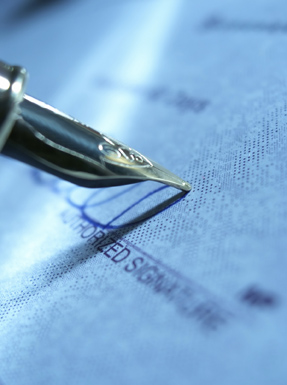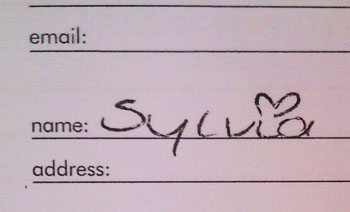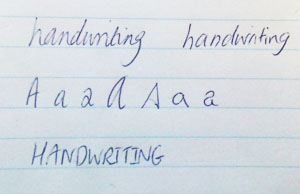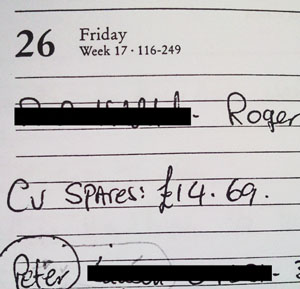Questioned Documents Examiner
 The questioned document is the item that bears a dubious signature or suspicious handwriting. It is necessary to have samples of handwriting or signatures from the suspects in the case, in order to prove their authorship or discount them from being responsible for the questioned writing.
The questioned document is the item that bears a dubious signature or suspicious handwriting. It is necessary to have samples of handwriting or signatures from the suspects in the case, in order to prove their authorship or discount them from being responsible for the questioned writing.
If the case involves questioned handwriting, it is important to obtain samples of handwriting in a similar style to that in question. For example, if the questioned writing has been written in block capital lettering, this can only effectively be compared to block capital handwriting samples. For lower case, un-joined (script) writing, the most relevant comparisons can be made with sample writing also in a lowercase, un-joined style. For joined-up, lower case (cursive) writings, the best evidence is obtained when comparing it to joined-up, lower case writings.
Where a case centres on a questioned signature, samples of the genuine signature need to be submitted in order to determine whether or not the signature is in fact genuine. Where forgery is suspected, it may also be helpful to have samples of the forgers own signature together with examples of signatures in the name of the victim (if possible) or written versions of the victim’s name. Remember not to show the suspect any examples of the questioned or genuine signature while taking specimen samples, as this may prompt disguised writings.
Reference writing
Reference or sample writing can be in the form of specimens taken by request, whereby you can dictate the sample; or in the form of course-of-business writing, which consists of examples of a person’s handwriting taken during the course of their everyday life, without knowledge of the forensic investigation. Often, such course-of-business writings are found to be helpful in establishing that any writing taken by request has not been deliberately disguised or modified. The forensic document examiner will need to make an initial comparison between all of the reference writings submitted to check that they have been written out by just one individual, as some course-of-business writing, particularly that taken form a shared residency, could be contaminated with writings from other individuals.
The forensic document examiner will need to make an initial comparison between all of the reference writings submitted to check that they have been written out by just one individual, as some course-of-business writing, particularly that taken form a shared residency, could be contaminated with writings from other individuals.Guidance for taking samples by request
Before taking request samples it is important to consider what type of writing would be the most appropriate to your individual case. It may be useful to speak to our forensic document examiner before taking samples to ensure that they will be of the best evidential value possible. It is particularly helpful to take samples of writing in a ball point pen ink, as these pens bear microscopic indicators of pen stroke direction which will assist the document examiner in determining how a character was constructed at a later point in time.It may also be useful to consider the following points:
What type of handwriting style is present in the questioned material? Lowercase, upper case, joined or un-joined lettering.

Are any numerals or symbols present? You will need to obtain examples of as many of the questioned characters as possible.
Is the writing on lined or unlined paper?
Is the writing on a form? The layout of the form my influence the size, spacing or layout of the writing, particularly in the positioning of signatures in signature boxes. Do you have a blank example of the form or a similar style of form to use? If not can you download or mock up a blank template?
Questioned signatures
When a signature is in question, it is essential to obtain several genuine reference signatures with which to compare it to, which are dated contemporaneously with that in question. In the majority of cases, a questioned signature would ideally need to be compared to ten or twelve reference signatures dated within a few months or years of that in question.Reference signatures
In order to obtain the strongest evidence possible for your case, we recommend that ten or twelve reference signatures are also submitted for comparison purposes, and these should ideally be dated within a few months or years of that in question.
This becomes particularly significant where very elderly or very young (teenage) persons are concerned. When people are in their later years, they often show tremors in their pen movements as their finer motor skills deteriorate, and some people may also pause or hesitate while writing out even something as familiar as their own signature, as they either pause to concentrate on moving their hand along the page from one resting position to another, or consciously focus on forming a particularly tricky writing shape. Such features are often similar to those shown by a forger as they attempt to suppress their own handwriting features and copy those of the model signature to be forged. Young people are continuously evolving and developing their own handwriting styles from the moment they learn to write up until their late teens or early twenties. A signature is often thought to be significant expression of an individual’s identity, and so young adults may experiment with several different styles or forms of their signature, until they settle on a favourite. It may therefore be necessary to examine additional reference signatures from such individuals in order to gain a deeper insight into the full range of features that appear naturally in their signature.
Questioned handwriting
 Where short handwritten entries are in question it is advisable to try to obtain several versions of the text, for example ten or so different versions of a questioned sentence or paragraph of text. Where longer passages of writing are in question, it may only be necessary to obtain a few versions of the questioned text, or samples of written paragraphs bearing combinations of the words in question. We would advise where possible that when taking request specimen writing, that you read the questioned text aloud rather than showing the writing to the writer, as they may be consciously or even subconsciously influenced to copying the questioned writings style or even to alter their own writing style.
Where short handwritten entries are in question it is advisable to try to obtain several versions of the text, for example ten or so different versions of a questioned sentence or paragraph of text. Where longer passages of writing are in question, it may only be necessary to obtain a few versions of the questioned text, or samples of written paragraphs bearing combinations of the words in question. We would advise where possible that when taking request specimen writing, that you read the questioned text aloud rather than showing the writing to the writer, as they may be consciously or even subconsciously influenced to copying the questioned writings style or even to alter their own writing style.While some people prefer to take writing exemplars which consist of versions of the ‘London Letter’ or the phrase beginning ‘the quick brown fox...’, we have always found that the best evidence can be obtained from examples of the questioned writing read aloud. This way the sample writing will contain examples of all of the letters, numerals and symbols found in the questioned text.
Forensic handwriting analysis as distinct from graphological studies
While both forensic handwriting examiners and graphologists both study the writing form, graphology is a distinct subject that studies the personality of an individual and is not a form of scientific analysis aimed at establishing the identity of the author.
Forensic casework can include a whole range of questioned documents and a variety of sources can be sought for suitable reference writings or comparison materials. It may be useful to analyze your document in a number of different ways, depending on the circumstances of the case. If in doubt please consult our expert, who will offer you free and impartial advice over the phone or by e-mail.
![]()
The business is temporarily closed,
we apologise for any inconvenience.
